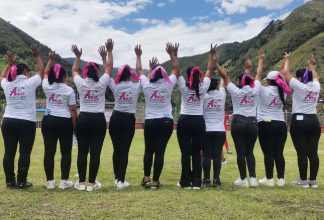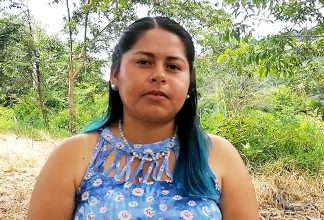Colombians Take to the Streets in Nationwide Protests

Since 21 November, tens of thousands of Colombians across the country have taken to the streets in a national strike against the government of president Iván Duque, amidst the wave of discontent that is being lived within Latin America.
The protests were triggered by the wide dissatisfaction against the government, due to announced labour and pension reforms, economic inequality and the slow implementation of the 2016 Peace Agreement, among other issues. Several groups including unions, students, pensioners, environmentalists, and human rights defenders initiated the protests.
Lack of protection for social leaders and activists
The National Indigenous Organization of Colombia –ONIC–, several NGOs, and many others are protesting against the lack of protection for indigenous people, social leaders, human rights defenders, and ex-FARC combatants, who are being murdered at alarming rates.
According to the ONIC, 135 indigenous people have been killed since the current government took office in 2018. Moreover, Colombian NGO INDEPAZ and the UN Verification Mission in Colombia have stated that 623 social leaders and human rights defenders and 158 ex-FARC combatants have been murdered since the adoption of the 2016 peace agreement.
The murder of governor Cristina Bautista and four unarmed indigenous guards of the Nasa community in Cauca, the resignation of the former minister of defence, Guillermo Botero, following an airstrike against a camp of FARC dissidents that left eighteen children dead, and the growing wave of violence in the country, are some of the issues that sparked the protests, evidencing the need for a new government strategy against violence in the country.
The protests are the largest in recent years
The continuing protests are the largest in the country in recent years. Although the majority of the protests were peaceful, with protesters banging pots and kitchenware in what is called a ‘cacerolazo’; confrontations between some demonstrators and riot police have also taken place. This has resulted in violence, looting, tear-gassing and excessive use of force by the police.
Hundreds of people have been injured and at least three people have died, including 18-year-old Dylan Cruz who was injured in the face by a tear gas canister launched by riot police. Additionally, prior to the protests, the police carried out raids against artists’ collectives, unions and activists in different cities across the country.
The government should address violence against social leaders
The increasing disapproval of Ivan Duque’s government was reflected in October’s regional and local elections, the first at the regional and local level since the peace agreement was signed. The governing Centro Democrático party lost in major cities like Bogotá and Medellín, while new political actors gained representation in several regions and municipalities.
Civil Rights Defenders and a group of Cuban partner organisations took part in an election observation mission organised by the Colombian Electoral Observation Mission –MOE– in Cúcuta, capital of Norte de Santander, on the border with Venezuela. Although the run-up to the elections was marred by violence in various parts of the country, the election day showed significant progress in security, political participation, and non-interference of armed groups, according to MOE. This is a sign that there are also improvements when it comes to the respect for human rights in Colombia.
The coming weeks are, however, crucial for the government’s credibility when it comes to human rights, as the protests continue. In order to decrease tensions and live up to its stated policy to reduce human rights violations, it needs to engage in a constructive dialogue with the opposition and respect and protect the rights of the citizens to peaceful protest and assembly. The government also has to effectively address the systematic violence against human rights defenders, social leaders and indigenous people.


